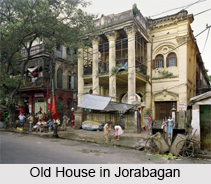 Jorabagan is an old urban area in north Kolkata. This place was covered with the palatial houses in Kolkata.
Jorabagan is an old urban area in north Kolkata. This place was covered with the palatial houses in Kolkata.
Location of Jorabagan
Jorabagan covers a small area but its importance is primarily because of the police station and the assembly constituency. It is located in northern fringe of Kolkata.
History of Jorabagan
Jorabagan means "a pair of gardens" in Bengali. It was so named because the road through it led to the garden houses of Gobindram Mitter and Umichand. There were the gardens which are now vanished. Jorabagan is part of old Sutanuti. It is in this neighbourhood that Job Charnock made his famous landing at Sutanuti ghat in 1690. Mohunton"s ghat between Beniatola and Sobhabazar ghats lurks the forgotten traditional landing place. There was a large tree under which Job Charnock is believed to have rested. The Sabarna Roy Choudhury Paribar Parishad and nine other intellectuals of the city filed a public interest litigation before the Kolkata High Court in 2001 demanding a probe into the matter whether Job Charnock can be regarded as the founder of Kolkata. The Court, upon an Expert Committee finding, declared that Job Charnock cannot be regarded as the founder of the city. Nimtala Ghat in the neighbourhood is the burning Ghat where Hindus cremate their dead. Amongst the more renowned people cremated there was Rabindranath Tagore and the place is marked with a memorial structure. Nimtala Ghat now has an electric crematorium.
Demography of Jorabagan
Jorabagan has a total population of 129,701 in the 2001 census, of which 77,367 were males and 52,334 were females. The entire area recorded negative decadal growth. The neighbourhood is dominated by Marwaris and is largely Hindi-speaking.
Related Articles
Kolkata
West Bengal, Indian State
Tourism in Kolkata
History of Kolkata
Chitpur
Sutanati
Gobindapur



















